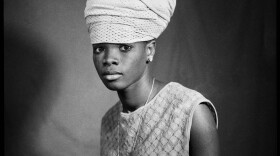At ’ February meet-up, a group of roughly 50 women mingled in a nook of . The building teemed with visitors, who dropped in and out of activities commemorating the start of . Here on the first floor, the melodic cadence of a spoken word artist punctured the air.
It was a fitting backdrop for Black Girls in Art Spaces’ first gathering of the year. The arts community founded by Dallas resident Kaci Merriwether-Hawkins exists to champion the work of Black artists and remedy a lack of racial diversity its members have felt as arts patrons.
The group invites Black women into galleries, museums, community centers, theaters — meeting artists wherever they are, Merriwether-Hawkins said. Events occur around the country and the world with 39 total chapters, but Black Girls in Art Spaces’ roots are in Dallas.
The atmosphere was jovial that February day. At one point, a woman broke into chants, saying “Here we go! Let’s do it!” and whipped out her phone, recording as she coaxed the group into an off-the-cuff dancing session.
Corralling the chit-chatty attendees into a hushed silence, Merriwether-Hawkins asked everyone to say their first names and then encouraged the group to disperse throughout the museum.
“We’re here to connect and see art,” she said.
‘I want to make this happen’

Around 2021, Merriwether-Hawkins began to share posts on social media about the art spaces she visited. In the comments section, she noticed a common refrain, people sharing sentiments to the effect of “dang, didn’t know this was in my city.”
She was particularly perplexed seeing these remarks from those who lived in coastal metropolitan areas such as Los Angeles and New York.
“There’s art literally all around you,” she thought.
In those early days, she saw her social platforms as a directory — a place to compile resources to fill in the gaps in people’s art knowledge.
Then, one night, she had a dream. The vision was simple: Black women together in a museum. Still, it was a revelatory moment for her.
She had attended art events in predominantly white spaces where there were only a handful of Black people. But the idea of seeing several Black people walk into a space together — seemed different.
“I want to make this happen,” she recalled thinking.
Roots in Dallas
Merriwether-Hawkins had roughly two days to organize the inaugural event for Black Girls in Art Spaces at in 2022 — a last-minute opportunity extended by the gallery’s eponymous owner, Daisha Board.
After posting about that gathering online, Merriwether-Hawkins said, there was an outpouring of people asking if the group would come to their city.
“I give so much credit to the community because I did not know this would grow into what it is today,” she said.

Christine Emesiani, Brittany Burden-Knox, Veronica Gilliams and MacKenzie Jenkins met at the group’s first event and came to the DMA gathering in February.
Together they roamed around the museum exhibit “,” which assembled almost 60 works by mostly artists of color, women and queer artists.
Standing near her three friends in the gallery, Jenkins, who is a Dallas-Fort Worth area native, said Dallas may not be top of mind when people think of art cities, but Black Girls in Art Spaces opened her eyes to the local scene.
Gilliams praised the group for sparking critical dialogue.
“We deserve to consume all of this art and appreciate this art, and bring up different perspectives and talk about provoking thoughts,” she said.
Emesiani, who mentioned attending a school in Oklahoma where she felt isolated as one of the only Black kids, said of Merriwether-Hawkins: “She’s created such a safe space.”

Giving Black artists recognition
As the group has expanded, Merriwether-Hawkins is keen on highlighting “unsung” art cities, especially those in the South, such as Montgomery, Ala., or Raleigh, N.C., where she has held events.
She also wants artists to see people engaging with their work, alluding to those who toil in obscurity during their life and are later met with posthumous fame.
“I’m so big on showing up for and supporting Black artists because I want them to get their flowers while they’re here, not just us discovering their works years after they’re gone. They deserve to be celebrated,” she said.
, has collaborated on several Black Girls in Art Spaces events, but one in particular stood out to her.
In 2023, she hosted an after-work gathering at her gallery, which was showing ’s resin pieces of little Black girls’ hairstyles.
Guests arrived that night dressed in pajamas and holding pillows. They sat on the floor, drank wine and had an informal Q&A with Vaniecia.
“We talked about being women, being Black women, our hair,” Gillespie said. “We just left lighter.”
Arts Access is an arts journalism collaboration powered by The Dallas Morning News and �Ļ�ӰԺ.
This community-funded journalism initiative is funded by the Better Together Fund, Carol & Don Glendenning, City of Dallas OAC, The University of Texas at Dallas, Communities Foundation of Texas, The Dallas Foundation, Eugene McDermott Foundation, James & Gayle Halperin Foundation, Jennifer & Peter Altabef and The Meadows Foundation. The News and �Ļ�ӰԺ retain full editorial control of Arts Access’ journalism.





